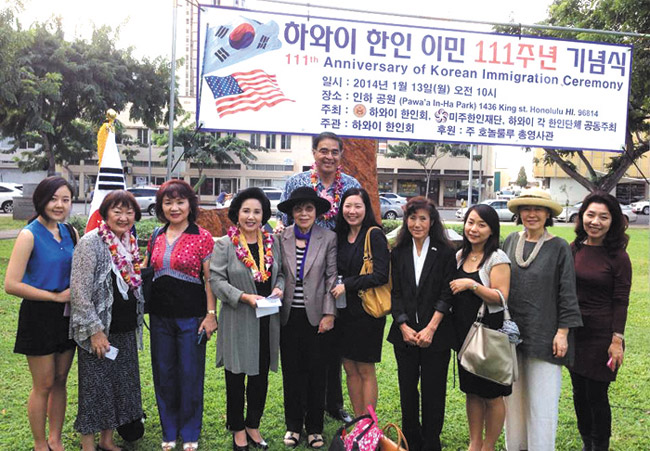Korean Drama Fever Continues To Rise

The author with supporters and friends of the Pawaa In-Ha Park (from left): Leah Song, Ann Kobayashi, Sunhee Kim, Sosuk Ko, Hwaja Park, Minnie Ko, Taeja Choi, Heejin Chang, Hyosuk Lee and Meehee Lee | Photo from Mufi Hannemann
My participation recently at Pawaa In-Ha Park, commemorating the 111th anniversary of Korean immigration to the United States, made me reflect on the myriad contributions Koreans have made to our Islands. Historical records show that 16 Korean nationals came individually to Hawaii in 1902, but the first real wave of Koreans arriving in our state came the following year via the SS Gaelic as it docked in Honolulu with 102 immigrants.
Having visited cities and led trade missions to South Korea, particularly Seoul, Incheon City, Busan and Jejudo, it reminds me of the richness of its heritage and culture. Although its local population is at 40,000, the contributions the Hawaii Korean community has made to the fabric of society, political system, economy, education, arts, food and entertainment are immeasurable.
Speaking of entertainment, I have become a huge fan of Korean drama in the 808. All 79 inches of me often is glued to my iPad, especially when I’m on the road, and on the DramaFever app. And guess what? I am not alone among the male populace of diehards in our community. For years, two of my former cabinet members, Tim Steinberger and Eric Takamura, often could be found talking up what they were following on KBFD-TV with the popular soaps’ female audience at City Hall. More recently, much to my surprise and delight, business executives including Walter Dods and Robin Campaniano, along with attorneys Bert Kobayashi Jr. and Rodney Veary and hundreds of others of the male gender, count themselves as devotees of K-dramas.
Dods and wife Diane easily could be dubbed “the first couple of Korean soaps” for the amount of time they spend watching their favorite series.
“I have a huge affinity for the historical ones, such as the tale of naval military leader Adm. Yi Soon-Shin, known for his courage and strategic brilliance in thwarting the enemy through his famous Turtle Ship,” explains Dods. He lists IRIS, an espionage series, as one of his all-time favorites. “I find the costumes and history of Korea so fascinating that if you see me on a flight riveted to my iPad, you know that I am busy watching you-know-what.”
Dods says he relies on Kobayashi and also on Jeff Chung, general manager of KBFD, a pioneer and expert on Korean drama, for hot tips on what he should view next.
Chung attributes the continuing popularity of Korean dramas to stories being “largely devoid of sex, drugs and violence, and core family values are a recurring theme.”
When asked why men are so late to the game in embracing these shows, especially a series with a romantic theme, Chung says, “Men don’t like to readily admit that they have a soft side because we are bound to cry a little bit at times.”
As one who shed a tear or two at The Sound of Music and at the ending of Splendor In The Grass, my favorite tearjerker is Stairway To Heaven, which is a classic that also was a big hit in Japan and the Philippines. If the title reminds you of an American song – yep, it’s the Led Zeppelin tune. In fact, the music is what I find extremely appealing. My favorite ballad is from Stairway – Bo Go Ship Da (I Miss You), which has me yearning to sing it in Korean – wishful thinking. My other favorite TV series is All In, shot in Korea and Las Vegas, starring Lee Byung-hun, whom I met through Chung at the 2005 Hawaii International Film Festival. Little did I realize then that Lee Byung-hun would break through on the American scene making a crossover to U.S. films.
So if K-dramas have started to pique your interest, make sure you set aside some quality time to watch them either at home or when you are traveling.
More importantly, be prepared to get hooked big time!
At the Pawaa In-Ha Park event, I also was pleased to connect again with Korean community leader Sosuk Ko. She headed the inaugural committee, which eventually adopted the park under my watch as Honolulu mayor.
Says Ko, “The Korean people of Hawaii did not have anything here that symbolized their hard work and perseverance. I wanted a special place to pay homage to our ancestors who came to this beautiful land and gave hope to our future generations. It only made sense to start with the park where the first centennial sculpture from Incheon, a sister city of Honolulu, was gifted.”
Second generation Korean-American and Ko’s daughter Minnie said it best in lauding her mother’s and other community leaders efforts:
“Our ancestors and parents worked hard and never gave up. They gave everything that they have to their children and respect their elders with every bone in their body. They have made Hawaii a better place to live!”
mufi@mufihannemann.com





